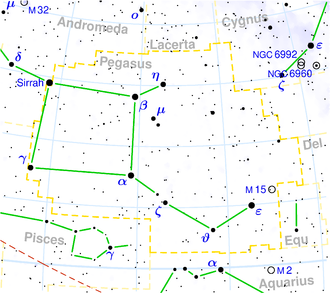NGC 7767
| Galaxy NGC 7767 |
|
|---|---|
![NGC 7767 with LEDA 1797966 [1] (above) SDSS image](https://upload.wikimedia.org/wikipedia/commons/thumb/d/d0/NGC7767_-_SDSS_DR14.jpg/300px-NGC7767_-_SDSS_DR14.jpg)
|
|
| NGC 7767 with LEDA 1797966 (above) SDSS image | |
| AladinLite | |
| Constellation | Pegasus |
|
Position equinox : J2000.0 , epoch : J2000.0 |
|
| Right ascension | 23 h 50 m 56.3 s |
| declination | + 27 ° 05 ′ 14 ″ |
| Appearance | |
| Morphological type | S0 / a |
| Brightness (visual) | 13.5 likes |
| Brightness (B-band) | 14.4 mag |
| Angular expansion | 1.0 '× 0.2' |
| Position angle | 142 ° |
| Surface brightness | 11.6 mag / arcmin² |
| Physical data | |
| Affiliation |
Abell 2666 WBL 724 |
| Redshift | 0.026728 ± 0.000090 |
| Radial velocity | 8013 ± 27 km / s |
|
Stroke distance v rad / H 0 |
(366 ± 26) x 10 6 ly (112.2 ± 7.9) Mpc |
| history | |
| discovery | Ralph Copeland |
| Discovery date | October 9, 1872 |
| Catalog names | |
| NGC 7767 • UGC 12805 • PGC 72601 • CGCG 477-017 • MCG + 04-56-016 • 2MASX J23505634 + 2705137 • GALEX ASC J235056.38 + 270513.7 • LDCE 1595 NED008 • HOLM 818B | |
NGC 7767 is a lenticular galaxy of the Hubble type S0 / a in the constellation Pegasus in the northern sky . It is estimated to be 366 million light years from the Milky Way and about 105,000 light years in diameter. Together with NGC 7765 , NGC 7766 and NGC 7768 , it forms the galaxy group Holm 818 .
The object was discovered by Ralph Copeland on October 9, 1872 .
